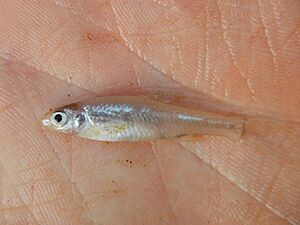Ghost shiner facts for kids
Quick facts for kids Ghost shiner |
|
|---|---|
 |
|
| Conservation status | |
| Scientific classification | |
| Synonyms | |
|
The ghost shiner (Notropis buchanani) is a small, silvery freshwater fish found in North America. It belongs to the Cyprinidae family, which includes carps and minnows. Ghost shiners are often confused with the Mimic Shiner because they look very similar. In fact, they were once thought to be the same kind of fish! This fish is known for its slender, torpedo-like body shape.
Contents
Where Do Ghost Shiners Live?
The ghost shiner lives in many places across North America. You can find them from the Mississippi River basin in the southern United States all the way up to Ontario in southern Canada.
Ghost Shiner Locations in the US
In the United States, ghost shiners live in states like eastern Kansas, southeastern Nebraska, and western Oklahoma. They also live south in northern Alabama, Mississippi, and Louisiana. You can also find them in rivers that flow into the Gulf of Mexico in Texas, Louisiana, and Mexico.
Ghost Shiners in Canada
In 1993, ghost shiners were found in southern Ontario, Canada. The first time they were seen in Ontario was in the Thames River watershed in 1979. Scientists first thought these fish were brought there by people. However, newer studies suggest they might have moved there naturally after the ice age ended.
What Do Ghost Shiners Eat?
Scientists haven't studied the exact diet of ghost shiners much yet. But it's believed that adult ghost shiners likely eat small things. Their diet probably includes insects, tiny water plants (called phytoplankton), and small creatures that live on the bottom of the water (benthic crustaceans).
Where Ghost Shiners Like to Live
Ghost shiners are fish that live both in the water column and near the bottom. They prefer areas in streams and rivers where the water moves slowly. They like streams that are not too big, usually from "order one" to "order four" on a stream size scale. In bigger rivers, they like parts with gentle slopes and water that is clear to a bit cloudy. They also enjoy large pools and calm areas without much current. Streams with lots of underwater plants are good homes for them. Many have been found among plants in the Ohio River valley.
How Dams Affect Ghost Shiners
Big structures like dams can be bad for ghost shiner populations. Dams block their movement and limit where they can live. Smaller dams, less than 12 feet high, are often not reported. These unregulated dams can be a big problem for ghost shiner populations.
Ghost Shiner Life Cycle and Reproduction
Ghost shiners usually start to breed when they are two years old. Their breeding season lasts from May until late August, depending on where they live. For example, in Tennessee, they might breed in late May. In Kansas, they might breed in mid-August. Most ghost shiners breed in their second summer. Not many breed in their third summer, as their lifespan is usually about three years.
Where Ghost Shiners Lay Eggs
Ghost shiners lay their eggs in rivers where the water moves slowly. They like areas with sand or gravel on the bottom. In Tennessee, they spawn in silty gravel areas below the Walter Hill Dam or in the silty sand of the Mississippi River.
Changes During Breeding Season
During the breeding season, male ghost shiners develop small bumps called nuptial tubercles. These bumps appear on their snout, around their eyes, and under their lower jaw. Their front pectoral fins also get a bit thicker.
How Big Do Ghost Shiners Get?
Young ghost shiners are about 0.8 to 1.5 inches long by October. When they are one year old, they grow to about 1.1 to 2.3 inches long. Adult ghost shiners are typically 1.3 to 2.3 inches long. The biggest ghost shiner ever caught was about 2.6 inches long!
Protecting Ghost Shiners
Currently, there are no special plans to manage or protect ghost shiner populations. Their numbers are stable in southern areas and in all states where they live. Compared to other fish in the Notropis group, ghost shiners are not very vulnerable.
Past and Present Status
The ghost shiner was once listed as a protected species in Ohio. This was because they were losing their natural homes. However, today, the ghost shiner is not listed as threatened or endangered in any state where it lives.
Challenges for Ghost Shiners
Before 1920, it was hard to track ghost shiner numbers. This is because they were thought to be a subspecies of the Mimic Shiner. Scientists believe there were more ghost shiners before they were found in Ohio in 1930. Losing their habitat, especially due to dams, is a big reason for their decline in the Ohio River Basin. Dams create barriers that stop fish from moving freely.
For example, ghost shiners used to live further up the Tennessee River. A collection in 1947 showed them in the lower Norris Reservoir. They survived for about 10 years after the reservoir was built. But now, they are considered to be gone from that area. Biologists from the TVA haven't found any there recently.
State and federal wildlife groups keep an eye on ghost shiner populations. They also monitor other native and non-native freshwater fish. But since ghost shiner numbers are stable, no specific actions are currently needed to protect them.


